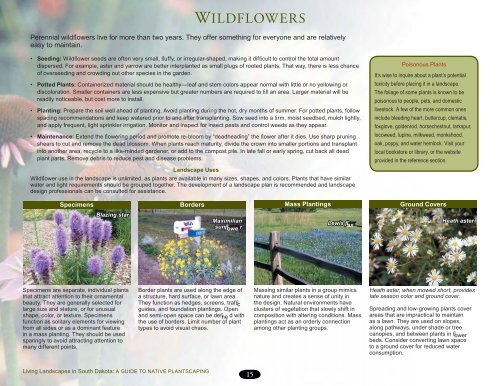Living Landscapes in South Dakota - Plant Materials Program - US ...
Living Landscapes in South Dakota - Plant Materials Program - US ...
Living Landscapes in South Dakota - Plant Materials Program - US ...
You also want an ePaper? Increase the reach of your titles
YUMPU automatically turns print PDFs into web optimized ePapers that Google loves.
WILDFLOWERS<br />
Perennial wildflowers live for more than two years. They offer someth<strong>in</strong>g for everyone and are relatively<br />
easy to ma<strong>in</strong>ta<strong>in</strong>.<br />
• Seed<strong>in</strong>g: Wildflower seeds are often very small, fluffy, or irregular-shaped, mak<strong>in</strong>g it difficult to control the total amount<br />
dispersed. For example, aster and yarrow are better <strong>in</strong>terplanted as small plugs of rooted plants. That way, there is less chance<br />
of overseed<strong>in</strong>g and crowd<strong>in</strong>g out other species <strong>in</strong> the garden.<br />
• Potted <strong>Plant</strong>s: Conta<strong>in</strong>erized material should be healthy—leaf and stem colors appear normal with little or no yellow<strong>in</strong>g or<br />
discoloration. Smaller conta<strong>in</strong>ers are less expensive but greater numbers are required to fill an area. Larger material will be<br />
readily noticeable, but cost more to <strong>in</strong>stall.<br />
• <strong>Plant</strong><strong>in</strong>g: Prepare the soil well ahead of plant<strong>in</strong>g. Avoid plant<strong>in</strong>g dur<strong>in</strong>g the hot, dry months of summer. For potted plants, follow<br />
spac<strong>in</strong>g recommendations and keep watered prior to and after transplant<strong>in</strong>g. Sow seed <strong>in</strong>to a firm, moist seedbed, mulch lightly,<br />
and apply frequent, light spr<strong>in</strong>kler irrigation. Monitor and <strong>in</strong>spect for <strong>in</strong>sect pests and control weeds as they appear.<br />
• Ma<strong>in</strong>tenance: Extend the flower<strong>in</strong>g period and promote re-bloom by “deadhead<strong>in</strong>g” the flower after it dies. Use sharp prun<strong>in</strong>g<br />
shears to cut and remove the dead blossom. When plants reach maturity, divide the crown <strong>in</strong>to smaller portions and transplant<br />
<strong>in</strong>to another area, recycle to a like-m<strong>in</strong>ded gardener, or add to the compost pile. In late fall or early spr<strong>in</strong>g, cut back all dead<br />
plant parts. Remove debris to reduce pest and disease problems.<br />
Landscape Uses<br />
Wildflower use <strong>in</strong> the landscape is unlimited, as plants are available <strong>in</strong> many sizes, shapes, and colors. <strong>Plant</strong>s that have similar<br />
water and light requirements should be grouped together. The development of a landscape plan is recommended and landscape<br />
design professionals can be consulted for assistance.<br />
Poisonous <strong>Plant</strong>s<br />
It’s wise to <strong>in</strong>quire about a plant’s potential<br />
toxicity before plac<strong>in</strong>g it <strong>in</strong> a landscape.<br />
The foliage of some plants is known to be<br />
poisonous to people, pets, and domestic<br />
livestock. A few of the more common ones<br />
<strong>in</strong>clude bleed<strong>in</strong>g heart, buttercup, clematis,<br />
foxglove, goldenrod, horsechestnut, larkspur,<br />
locoweed, lup<strong>in</strong>e, milkweed, monkshood,<br />
oak, poppy, and water hemlock. Visit your<br />
local bookstore or library, or the website<br />
provided <strong>in</strong> the reference section.<br />
Specimens<br />
Borders<br />
Mass <strong>Plant</strong><strong>in</strong>gs<br />
Ground Covers<br />
Blaz<strong>in</strong>g star<br />
Maximilian<br />
sunflower<br />
Lewis flax<br />
Heath aster<br />
Specimens are separate, <strong>in</strong>dividual plants Border plants are used along the edge of Mass<strong>in</strong>g similar plants <strong>in</strong> a group mimics<br />
that attract attention to their ornamental a structure, hard surface, or lawn area. nature and creates a sense of unity <strong>in</strong><br />
beauty. They are generally selected for They function as hedges, screens, traffi c the design. Natural environments have<br />
large size and stature, or for unusual guides, and foundation plant<strong>in</strong>gs. Open clusters of vegetation that slowly shift <strong>in</strong><br />
shape, color, or texture. Specimens and semi-open space can be defi ne d with composition with alter<strong>in</strong>g conditions. Mass<br />
function as solitary elements for view<strong>in</strong>g the use of borders. Limit number of plant plant<strong>in</strong>gs act as an orderly connection<br />
from all sides or as a dom<strong>in</strong>ant feature types to avoid visual chaos. among other plant<strong>in</strong>g groups.<br />
<strong>in</strong> a mass plant<strong>in</strong>g. They should be used<br />
spar<strong>in</strong>gly to avoid attract<strong>in</strong>g attention to<br />
many different po<strong>in</strong>ts.<br />
Heath aster, when mowed short, provides<br />
late season color and ground cover.<br />
Spread<strong>in</strong>g and low-grow<strong>in</strong>g plants cover<br />
areas that are impractical to ma<strong>in</strong>ta<strong>in</strong><br />
as a lawn. They are used on slopes,<br />
along pathways, under shade or tree<br />
canopies, and between plants <strong>in</strong> fl ower<br />
beds. Consider convert<strong>in</strong>g lawn space<br />
to a ground cover for reduced water<br />
consumption.<br />
<strong>Liv<strong>in</strong>g</strong> <strong>Landscapes</strong> <strong>in</strong> <strong>South</strong> <strong>Dakota</strong>: A GUIDE TO NATIVE PLANTSCAPING<br />
15

















